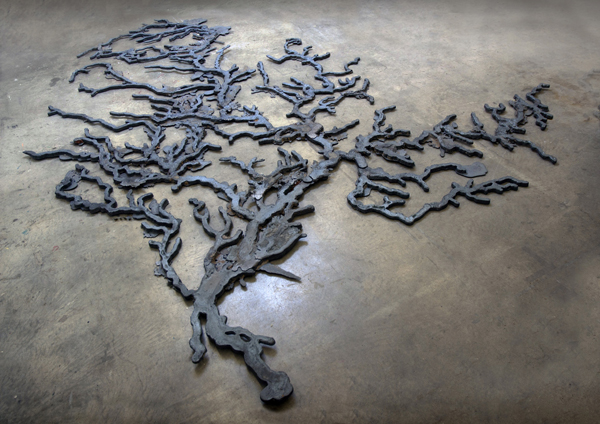There are perhaps no things more emblematic of human identity in the American tradition than the representation of the human corpus we inhabit and the land on which we tread. Tamsie Ringler’s recent body of work, Landscapes and Portraits, accepts and reimagines this longstanding approach. Her small scale cast iron sculptures of private, even intimate, creative spaces of important acquaintances and overlooked patches of ground do indeed belong to the same artistic and intellectual project as the enormous nineteenth century oil paintings of the western mountains by Thomas Moran. Private and homage like, the people and places connected to the spaces Ringler recreates in iron are all individuals and locations personally connected to the artist. It is this sense of connection that justifies the small scale on the levels of commonality and the infinitely more immense notion of the deeply subjective and connected.
Key to Ringler’s own personal version of this grand narrative of identity, seen through and as the body and the landscape, is her particular use of iron. Measured by mass, iron is the most common element on earth. While ubiquitous, it has from its earliest human uses been associated with the monumental. As such, the ordinary is transformed into the extra-ordinary, the common into the exceptional. Ringler’s work with iron includes massive projects in which she directs teams of workers to complete large-scale sculptures that can undeniably be seen as monumental. Her intimate relationship to and feelings about the iron, however, make even the large-scale work seem personal in nature. In fact, her rapport with the material itself is another affiliation being paid homage in this series.
Ringler’s 2015 River of Iron: Pouring the Mississippi exemplifies the complex set of relationships that make up the matrix that is her work – artist to people, artist to place, artist to material – in an at once spectacular and introspective manner. Poured on the banks of the Mississippi on the grounds of the Weisman Art Museum at the University of Minnesota during the 2015 dusk to dawn Spark festival in Minneapolis, this cast iron performance, as the artist terms it, utilized its location and the night time darkness to intensify the solemn and meditative aspect of the work. Precisely and deliberately, a team of artists, under Ringler’s direction, poured molten iron through a cast of the entire watershed of the great river. As with Ringler’s work, the river is expansive – reaching to all the edges of the landmass it bifurcates. In all its tributaries and connected waterways it models the artist’s practice. Though iconic and monumental in reality and lore, the river is in fact a part of a vast network of connections, pulsing with not only the water rushing through its banks but also with the life – both ordinary and grand – that exists on its edges and extremes, connecting so much through the shared attachment to it.
For Ringler, the Mississippi is close. She lives on its banks. It is also a symbol of the far reaches that it spans and, by implication, what is beyond them. Through the act of pouring a river of iron, the work encapsulates the bringing together of seemingly disparate elements, including public and private, massive and infinitesimal. River of Iron is key to the overall body of the landscapes and portraits work in that through the artist’s personal connections to the river, her co-workers, and the material of iron, it is ultimately both a landscape and a portrait. Perhaps the most telling evidence of this network of connections for the artist is the quiet tribute amongst tributes revealed in the simple dedication to Maris Strautmanis, the artist’s late husband. Like time itself, conceived in one way, the river as Ringler presents it in both the performance and the resulting sculpture is both endless and finite. It all depends on how each of us views it at distinct points in time.
Diane Mullin, Senior Curator
Weisman Art Museum, Minnesota, USA
Landscapes and Portraits - Essay by Amy Hamlin, Professor of Art History, St. Catherine University, MN
Landscapes and Portraits: Process
River of Iron: Pouring the Mississippi
